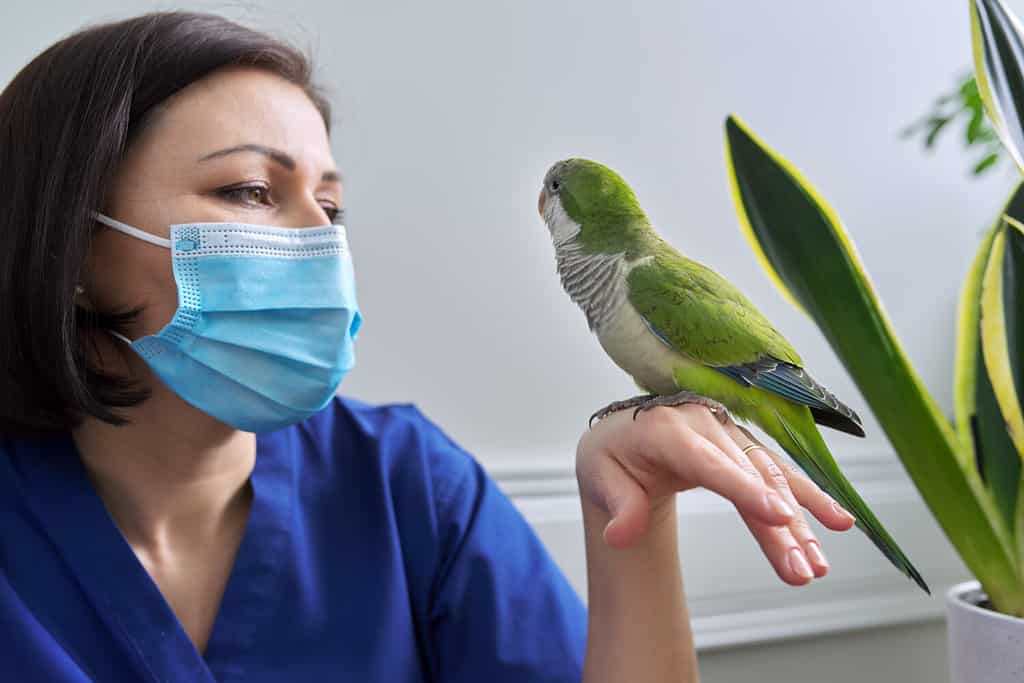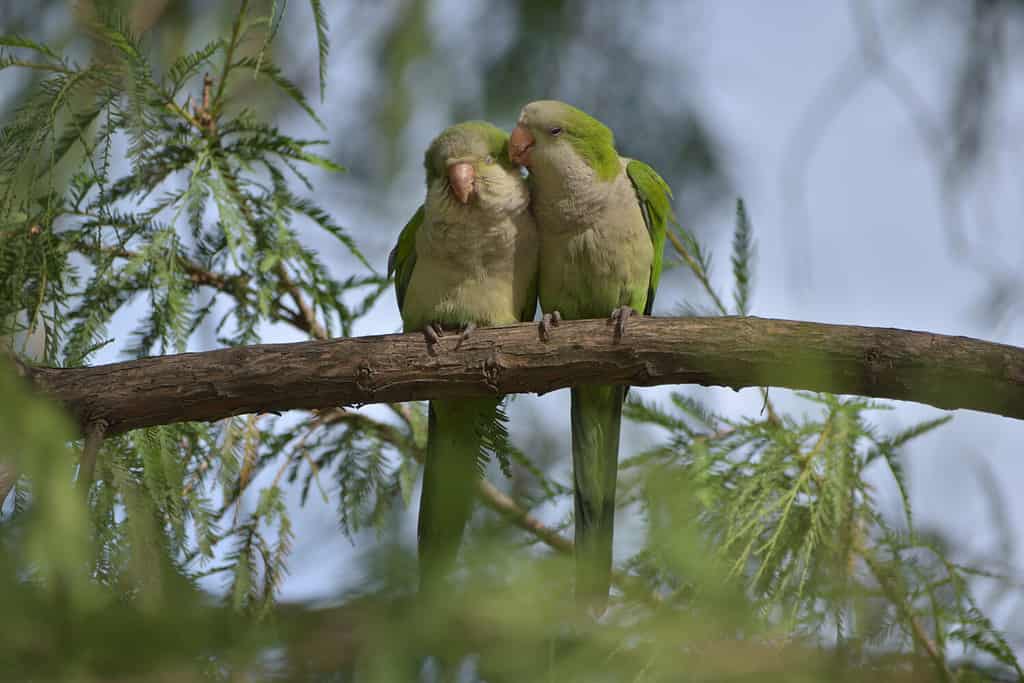So you’re thinking of buying a new pet bird, and you want to know if it’s female or male. Quaker parrots (Myiopsitta monachus), also known as monk parakeets, are often kept in captivity as they make entertaining pets. They can mimic human speech, which can make them very funny to have around. Apparently a parrot has even been known to give a TED talk! It is illegal to keep Quaker parrots as pets in at least 14 states, so check the rules where you live before acquiring one. Several other states may require that you clip your bird’s wings or apply for a permit to own one.

Quaker parrots in captivity may not thrive, especially if they do not have a partner.
©VH-studio/Shutterstock.com
Quaker Parrots in the Wild and in Cities
In the wild, Quaker parrots build elaborate “apartment-house nests” with multiple chambers, capable of housing 20-200 families. These are the only parakeets that live communally. They may use different chambers of the nest for different purposes (breeding vs. roosting, for example). Occasionally, other birds will make use of an abandoned parrot nest.
Some cities have feral colonies of Quaker parrots, which build their large nests of twigs on telephone poles or other elevated settings. They are considered a nuisance by utility companies for this reason. The Quaker parrot is also seen as an invasive species outside of urban areas. It does damage to crops as well as threatening or displacing some native birds.

A parrot “apartment” may contain dozens, even well over 100, nests inside.
©V_E/Shutterstock.com
Females and Males: Can You Tell Them Apart?
Want to know whether you have a male or female Quaker parrot (or a matching pair)? It will cost you. One of the most reliable methods is to check the parrot’s DNA with a blood sample (from the bird’s leg). There are also those who try to check the DNA through a bird’s feather. It remains to be seen which annoys the bird more: plucking its feathers or drawing its blood.
Some opt for a surgical method. This requires cutting the bird open, though, to inspect the reproductive organs through an endoscope. While this is a reliable way to determine the sex of a parrot, any wound can be susceptible to infection (and sedation is involved).
Does Size Really Matter?
The female monk parakeet can be about 20% smaller than the male, but they often appear the same size. Also, in a monomorphic species, everything else about them is visually identical to the human eye, as well. Scientists have found subtle differences between the plumage of males and females, but it is visible only to other birds.
Those who prefer not to seek a DNA test or exploratory surgery may also swear that you can tell a female Quaker parrot from a male by the width of her hips. Others suggest this is not a reliable indicator, as male parrots develop wider hips as they grow.

Difference in color between males and females can be seen by birds, but not humans.
©Christian Peters/Shutterstock.com
Parrots Behaving Badly
There are instances where Quaker parrots can be aggressive or loud. Some have attempted to argue that there are differences between female and male parrots related to aggression, loudness, how much they talk, etc. Myth-busters counter that loudness or aggression comes when a parrot is lonely or wants more attention. It has nothing to do with whether it is a male or female bird.
As we have already established, Quaker parrots thrive in community — they want company. If you had one for a pet, it would bond strongly to you. Or, if you had two, they might bond well with each other. But whether a bird is friendly or cuddly is not based on its sex, either.
Lipid Disorders in Quaker Parrots
It is not unusual for parrots in captivity to experience disorders related to lipid (fat) metabolism. As it turns out, male Quaker parrots are three times more likely to experience fatty-liver syndrome than their female counterparts. Researchers at Canada’s University of Guelph found in 2020 that males and females differ in the kinds of lipids most present in their plasma, which may explain this imbalance.
In considering why females and males do not store the same kinds of lipids, the researchers note, “These differences are likely explained by the specific female lipid metabolism associated with egg laying (vitellogenesis).” Members of the same research team have been experimenting with altering the diet of Quaker parrots to see how diet influences lipid levels and metabolytes in their plasma. One study even looked at using atorvastatin — a medication used to lower cholesterol in humans — in birds. Researchers hope eventually to make recommendations for improving the health of parrots.
Thank you for reading! Have some feedback for us? Contact the AZ Animals editorial team.








